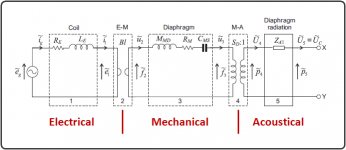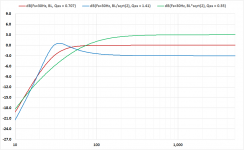I don't know much about Hornresp. Can someone tell me how the sim uses BL (the force of the magnet in the gap on the length of the voice coil) in producing simulations?
Can someone please illustrate with different plots and predictions (esp transient behaviour) how it would handle two sub drivers differing only in BL.
Thanks.
B.
Can someone please illustrate with different plots and predictions (esp transient behaviour) how it would handle two sub drivers differing only in BL.
Thanks.
B.
Two sub drivers cannot differ *only* in Bl - the parameters interact enough that that would be impossible.
Qes at least would be different.
Qes at least would be different.
Two sub drivers cannot differ *only* in Bl - the parameters interact enough that that would be impossible.
Qes at least would be different.
Can't you answer the question by assuming - for purposes of analysis - that only BL changed? Or given a BL change of say, 30%, to estimate a realistic figure for Qes change?
Funny, this question seems to have stumped people for the moment (12 hours and counting). Isn't it a question worth asking since BL and magnet weight are important in buying a driver? Or the torque/RPM curve and cylinder displacement of the engine in buying a car?
B.
Last edited:
You’re a smart guy, I’m sure you can appreciate why some people may be reluctant to invest time in responding to a query from you regarding Hornresp…but the underlying question of the affect of changing BL on woofer response is a good one.…Funny, this question seems to have stumped people for the moment …
Most modeling software (including Hornresp) use a lumped parameter model for loudspeakers where BL defines the transduction coefficient between current(electrical domain) and force(mechanical domain). Keeping all other mechanical and electrical parameters the same, if you increase BL by a factor of sqrt(2) = 1.414, Qes will be halved and mid-band sensitivity will increase by +3dB; reduce BL by sqrt(2) and Qes will be doubled and mid-band sensitivity will decrease by -3dB.
Plots often aid in understanding interrelated trends like this. For illustrative purposes, let’s assume a woofer with Fs = 30Hz operating in an infinite baffle, and mechanical damping is extremely high so that damping is completely dominated by electrical damping(Qes) which was set to 0.7071 by initial choice of BL. Then BL is factored up and down by sqrt(2).
Regarding transient behavior, what exactly are you interested in? (impulse, step, burst,…etc).
All types of transient behavior is directly tied to the frequency response of the woofer.
You may also find these papers on High-BL and Low-BL drivers of interest:
[PDF] Direct-radiator loudspeaker systems with high Bl | Semantic Scholar
(PDF) High-Efficiency Low-Bl Loudspeakers

